(Written by William)
When I built one of the smaller sets in the LEGO Hidden Side series, I thought the experience was rather novel. So, I wanted to see what the most expensive set in the collection offered. Let’s start with what’s included in the set, then we can talk about some of the interesting building techniques.
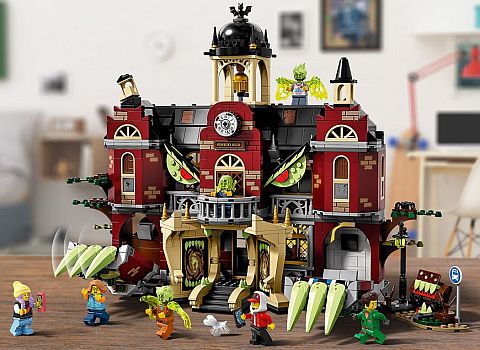
The #70425 Newbury Haunted High School features a rundown high school with broken architectural details. I’m not a huge fan of just how many stickers are in the set, but I have to admit they really add to the overall look of the structure. And, if it ended there, I’d think that this would still be a decent set. But there is more. A major feature of all the LEGO Hidden Side sets is their ability to transform and show their haunted hidden side. Something like this could turn out to be a really cheesy play-feature, but I was delighted to discover that this is not the case at all. The transformational features are all very clever and they were refreshing to build and a pleasure to play with. But wait, that’s not all! If you have a smart device that has the capability, you can also have an interactive augmented reality game experience with the set.
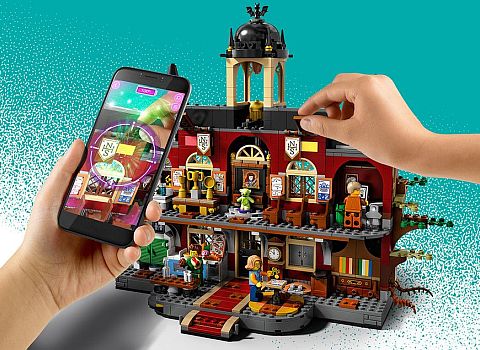
Sadly, I don’t have a device sophisticated enough to run the app. I have heard from others that the play experience with the app is a bit repetitive. However, if you think of the augmented reality feature as an add-on, and not the whole play-experience, it’s actually a quite remarkable concept. (You can watch JANGBRiCKS’ reviews here, where he demonstrates how the app works with the various LEGO Hidden Side sets.)
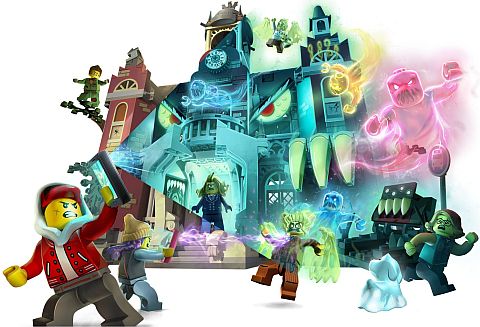
Without the app, I may not be able to enjoy all the features of this LEGO Hidden Side set, but I’m satisfied with just the built-in play features even without a compatible electronic device. And that’s saying something, as I’m usually not a fan of childish play features. In the video below, I will share some more overall thoughts about the set, then we will discuss several of the building techniques.
LOCATION AS A CHARACTER WITH LEGO
For the longest time, I have wanted to address this topic. The problem is that, up until now, I’d have to talk about it in abstract ways. The idea that you can turn a location into its own sort of character is kind of hard for people to imagine. But when the building itself actually transforms into a giant possessed building… well, that’s easier to talk about.
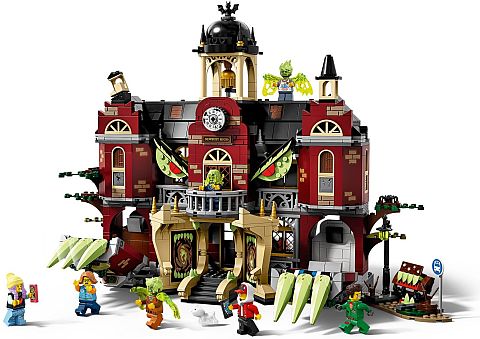
Generally, when you build a location, it really helps to give it some personality. You do this by the colors you use, the format of the building, and by making the building project some sort of impression. In this set, we see a decrepit high school that once was famous. It has a dark and forbidding sense about it even when it’s not in haunted mode. Open it up and you can literally see the malevolence about the place. The door opens ready to devour those who draw near, and the windows look down ominously at passersby. These features are even more obvious when the building turns haunted and the doorway becomes a mouth and the eyes unfold from the upstairs windows.
Moving to the sides of the building, the rounded out walls stand like massive limbs preparing to pounce. Meanwhile, the entire edifice radiates creepy energy. This is made more real as claws spring forth from the sides of the building and the tops peel back to usher out ghostly wisps of power.
In every way, the monster that appears from this school is a manifestation of the personality it already has. It’s important to note that this doesn’t always have to be a scary characterization. I’d say the best way to approach this technique is to make up some simple elements like eyes and a mouth. Then, when you’ve made your creation, hold these eyes and mouth pieces up to see if the character you have in mind fits what you are going for. Keep in mind this is more of a subconscious level of building a model. Ideally, the end goal is to set a tone for what you’ve made. After all you don’t want to have happy vibes coming off something that isn’t supposed to look cheerful.
NON-RELATIVE SPACE WITH LEGO
In order to fit all the special monster features of this model, it was necessary to have a bit of extra space. LEGO designers accomplished this by creating some non-relative space in the school. This means parts of one side of the building don’t match up to the other side. In other words, these spaces don’t relate to one another, thus non-relative spaces.
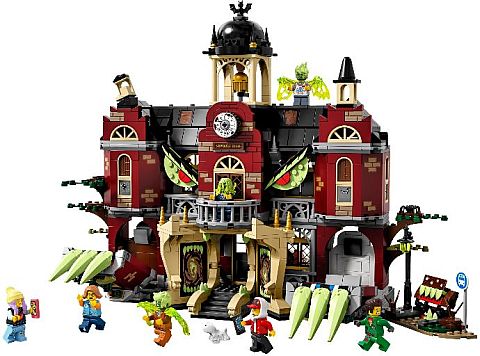
The odd thing is, you can still see some windows that do line up with the backside. However, even these are encased with extra fencing and frames to create the illusion of distance. The important part is that some of these windows don’t appear on the inside of the building. Provided you can make it look nice and believable, if you can create these non-relative spaces, then you have all the room you need. Truth be told there is a limit to how much you can abuse non-relative space. But when done well, these pockets of unaccounted for space become less important and that’s the real goal.
The key to this technique is to make the areas that do connect be the more interactive parts of the model, while the ones that don’t connect be less interactive. We see this with the windows and doors that we can open and close. These directly relate to one another, so having them work is great. Meanwhile, the less interactive windows that are smaller and more on the decorative side are used in the non-relative spaces. The smart thing here is that these spaces are going to be still used for the haunted version of the building. People have less problems with unused spaces as long as they serve a purpose. So, as far as the building goes, it’s a non-relative space, but as for the play functionality, it’s all toy!
MAKING TRANSFORMATIONS WITH LEGO
I kind of hate to talk about these techniques, since they are some of the best things about building this set, and I don’t want to spoil the experience for anyone. Yet I can’t ignore them either. So I want to instead talk in more general terms of how to go about creating a transforming mechanism.

To start, you will need to have a clear idea of two distinct forms. Let’s call them position A and position B. Now it is entirely possible to have more than two positions, but, for simplicity sake, we’ll just stick with the two. These positions will define what the object changes into or from, depending on your point of view. Next, think of each position and try to determine what needs to be there to make them look right. Do you need a wall? What size do the eyes need to be? Is it important for something to be sturdy? What you’re trying to do is figure out everything you can’t compromise on.

Once you understand what hard limits need to exist, then you can start thinking outside the box in terms of what can be done to move your creation from one position to the next. The funny thing is, one aspect that is usually never a limitation is using the space beyond where you want the transformation to take place. Take for instance the mouth of the high school. The trigger to open and close this is the back steps of the model which is clear on the opposite end of the set. Meanwhile the claws use the interior rooms as trigger points, and the wispy ghost fumes use the roof tops that are being pulled away to operate their effects. So when it comes to using outside-the-box type thinking, I really mean that you need to focus on what you can use outside the area. Ultimately, this will allow you to have a little more room figuring out the tricky moving parts for the transformation.
STAIR STEPPING & COMIC STRIPPING WITH LEGO
Having play areas is fine with a LEGO model. However, if you have trouble getting to fit things, it can be a real pain. So we’re going to look at two methods to save a lot of space in your creation. Neither of these techniques is particularly difficult, so I figured I’d talk about them together.
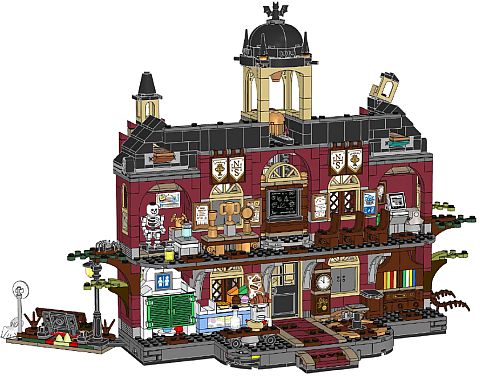
First up is stair stepping. This is where you put the lower level out farther than the level above it. In essence you create a stair step look. Additionally, the upper level doesn’t overhang the first level so it’s easier to reach and play with all the elements.
A good technique to pair with stair stepping is comic stripping. Now that you’ve made the upper level shorter in terms of depth you now have a different issue. You don’t have the same amount of play area. This is where comic stripping comes in handy. Instead of treating the play area like a fully fleshed out three dimensional space design, it is instead like a comic strip you might find in a newspaper. You do this by either presenting everything full on or directly to its left or right side.
For an example, take a look at the second floor classroom. The chalkboard is not even facing the desks properly and all the seats face directly left. In real life, this would be a terrible classroom design. However, if it were a comic strip then the reader could easily see what’s going on. In theater circles, this is also referred to as facing out. Typically these techniques work best for having better play access to your creation. But they can also be really useful when making dioramas or any scene where you want to have better exposure.
APPLYING WHAT YOU LEARN
As a set, the #70425 Newbury Haunted High School really grabs people’s attention. It is a great looking building, mostly due to the fact it has a sense of what it’s trying to be. Having the ability to then transform into this character makes it all the more real. Putting this effort in will change a bland creation into one that is much more captivating.
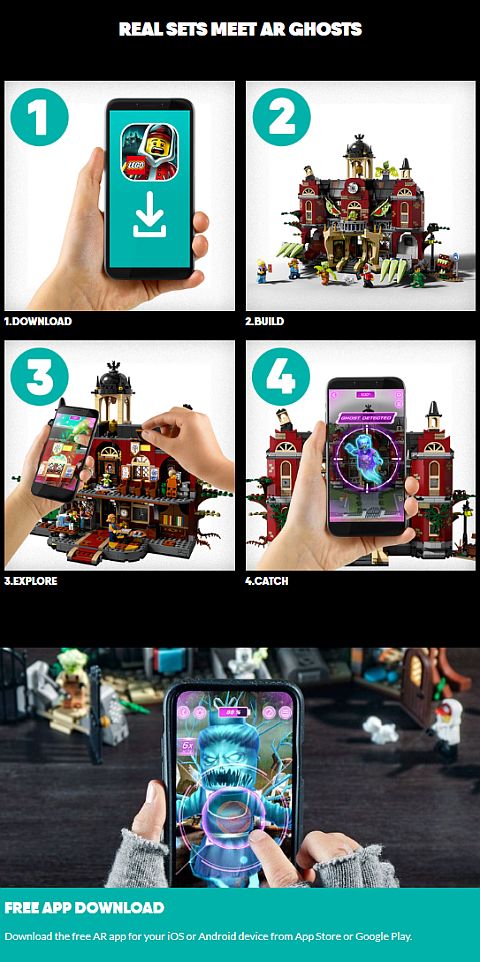
Having a sense of character seems contrary to using non-relative spaces. After all, a good character will use every inch of space possible, right? Well, actually it does. The only thing is that this model is building two different things into one. By utilizing non-relative space, there is room to get very clever with the model’s more special features.
Speaking of which, the way this thing transforms is impressive. This set features pop-up mechanics, simple release mechanisms, spring loaded effects, and hard control mechanisms. And I didn’t even address the locking hidden panel. Needless to say, there are dozens of ways to transform a model from one thing to another. The important factor is to set parameters for yourself to give you the best shot of making the transformation look the best as possible.
And if that wasn’t enough, you can do some simple things to make your creation better seen and easy to play with. All of this is packed into a single package, which has augmented reality as an added way to interact with the set. Honestly, I wanted to see just how much the LEGO Hidden Side sets could really offer, and the Newbury Haunted High School does that hands down. If I wasn’t convinced already to pick up the rest of these sets, this would have done the job. You can check out the whole collection at the LEGO Hidden Side section of the Online LEGO Shop.

What do you think? How do you like the LEGO Hidden Side sets? Do you have any of them already? And what do you think of the haunted high school and the techniques used? Feel free to share your thoughts and discuss in the comment section below!
And you might also like to check out the following related post:












It’s great to see that the set is enjoyable without the app. I heard that these sets don’t sell well because still relatively few people have the fancy phones it requires. And the box art isn’t too appealing either. But I like the transformation features. It reminds me of the Monster Fighters sets.
Yeah, it’s not going to be too surprising if these sets don’t hang around too long thanks to the phone barrier. When they do go on sale they are well worth picking up.
This and the train are what my boys are most curious about. Will you review the train too? We’re happy to hear the app is not essential. The transformation features seem like a lot of fun. Who wouldn’t what their school turn into a monster?
Yes! The train review is on the way.
I sent in all the files so we’re just waiting for a good window for the admin to post it up. Spoiler, I like the Ghost Train Express too!
I greatly appreciate your suggestion about making transforming features. I often get so focused on making it realistic that I forget that the only thing important is how it works and looks. Your tips are especially important when building smaller mocs. It’s not possible to fit everything in and keep it realistic. Greebling and working functions can hide missing details.
That’s something I’m struggling with as well. I always go for perfection and it’s not always beneficial. The Exo Suit thought me a lot about what to keep functional and what to simulate with greebling.
I think the mindset of “I have to get everything right” is something most fans struggle with. I know I have the same issue, but as I’ve seen that is just not the halmark of a great creation.
Plus it’s surprising how refreshing it is creatively to build one of these transforming elements.
This would be a cool set to decorate for Halloween. I think a lot of people got turned off by their phones not working with these sets. My local store is full of them. They will probably get discounted after Halloween.
I know I was a bit leary of the fact these sets called for an app. And they’re advertised so heavily to the point that is all you can see on the box art.
I’m happy to say, everything I’ve built in the line has LEGO’s “A” team on this series and I’m just chomping at the bit to get everything put together. And I have a basic flip phone which definitely doesn’t run the app.
Honestly, snag these on a sale you can’t miss.
Hmmm, space is starting to become a bigger concern to me than money, and despite the game connection, the theme doesn’t seem to have much of a premium cost compared to related City and Ninjago sets, anyway.
There’ll also be 10 new sets appearing next year, according to Brickset, so I guess Lego still has some faith in the theme. If I come across a really good sale, I might possibly buy some box, though, or maybe some interesting parts will turn up in second hand bulk bags in a few years.
Six new sets in January, as well as six more during summer or autumn, it seems.
https://www.stonewars.de/lego-2020/
(Most of the info is in German, but I guess you can still make out the gist, or web translate most of what you don’t understand already.)